Design Optimization of an Axial Flux Magnetic Gear by Using Reluctance Network Modeling and Genetic Algorithm
Abstract
1. Introduction
2. MEC-RN Model of the AFMG
2.1. Operation Principle and Configuration
2.2. Layer Division and Categorization of Reluctances
2.3. Considering Non-Linearity in Ferromagnetic Materials
3. System Solution
3.1. Matrix System Assembly Using a Mesh-Based Formulation
3.2. Solution of the Mesh-Based MEC Model
4. Optimization and Validation of the MEC-RN Model
4.1. Genetic Algorithms
4.2. Multi-Objective Function
4.3. Optimization Results
5. MEC-RN Evaluation and Performance Analysis of the Optimized AFMG
6. Conclusions
Author Contributions
Funding
Data Availability Statement
Acknowledgments
Conflicts of Interest
References
- Jian, L.; Chau, K.T. Analytical Calculation of Magnetic Field Distribution in Coaxial Magnetic Gears. Prog. Electromagn. Res. 2009, 92, 1–16. [Google Scholar] [CrossRef]
- Li, X.; Chau, K.T.; Cheng, M.; Hua, W.; Du, Y. An improved coaxial magnetic gear using flux focusing. In Proceedings of the International Conference on Electrical Machines and Systems (ICEMS), Beijing, China, 20–23 August 2011; pp. 1–4. [Google Scholar]
- Gardner, M.C.; Jack, B.E.; Johnson, M.; Toliyat, H.A. Comparison of Surface Mounted Permanent Magnet Coaxial Radial Flux Magnetic Gears Independently Optimized for Volume, Cost, and Mass. IEEE Trans. Ind. Appl. 2018, 54, 2237–2245. [Google Scholar] [CrossRef]
- Desvaux, M.; Sire, S.; Hlioui, S.; Ben Ahmed, H.; Multon, B. Development of a Hybrid Analytical Model for a Fast Computation of Magnetic Losses and Optimization of Coaxial Magnetic Gears. IEEE Trans. Energy Convers. 2019, 34, 25–35. [Google Scholar] [CrossRef]
- Wang, J.; Qian, L.; Xu, S.; Mo, R. Analysis of Electromagnetic Performance of Modulated Coaxial Magnetic Gears Used in Semi-Direct Drive Wind Turbines. J. Ass. Energy Eng. 2021, 118, 251–264. [Google Scholar] [CrossRef]
- Zhu, D.; Yang, F.; Du, Y.; Xiao, F.; Ling, Z. An axial-field flux-modulated magnetic gear. IEEE Trans. Appl. Supercond. 2016, 26, 0604405. [Google Scholar] [CrossRef]
- Mezani, S.; Atallah, K.; Howe, D. A high-performance axial-field magnetic gear. J. Appl. Phys. 2006, 99, 08R303. [Google Scholar] [CrossRef]
- Lubin, T.; Mezani, S.; Rezzoug, A. Development of a 2-D analytical model for the electromagnetic computation of axial-field magnetic gears. IEEE Trans. Magn. 2013, 49, 5507–5521. [Google Scholar] [CrossRef]
- Zhou, T.; Huang, Y.; Dong, J.; Guo, B.; Zhang, L. Design and modeling of axial flux permanent magnet machine with yokeless and segment armature using magnetic equivalent circuit. In Proceedings of the 2014 17th International Conference on Electrical Machines and Systems (ICEMS), Hangzhou, China, 22–25 October 2014; pp. 618–623. [Google Scholar]
- Amrhein, M.; Krein, P.T. 3-D Magnetic Equivalent Circuit Framework for Modeling Electromechanical Devices. IEEE Trans. Energy Convers. 2009, 24, 397–405. [Google Scholar] [CrossRef]
- Fukuoka, M.; Nakamura, K.; Ichinokura, O. Dynamic analysis of planetary-type magnetic gear based on reluctance network analysis. IEEE Trans. Magn. 2011, 47, 2414–2417. [Google Scholar] [CrossRef]
- Holehouse, R.C.; Atallah, K.; Wang, J. A linear magnetic gear. In Proceedings of the 2012 XX International Conference on Electrical Machines (ICEM), Marseille, France, 2–5 September 2012; pp. 563–569. [Google Scholar]
- Fukuoka, M.; Nakamura, K.; Ichinokura, O. A method for optimizing the design of SPM type magnetic gear based on reluctance network analysis. In Proceedings of the 2012 XX International Conference on Electrical Machines (ICEM), Marseille, France, 2–5 September 2012; pp. 563–569. [Google Scholar]
- Fukuoka, M.; Nakamura, K.; Ichinokura, O. RNA-Based optimum design method for SPM type magnetic Gears. J. Magn. Soc. Jpn. 2013, 37, 264–267. [Google Scholar] [CrossRef]
- Wu, Y.-C.; Juan, B.-S. Magnetic field analysis of a coaxial magnetic gear mechanism by two-dimensional equivalent magnetic circuit network method and finite-element method. Appl. Math. Modell. 2015, 39, 5746–5758. [Google Scholar] [CrossRef]
- Thyroff, D.; Meier, S.; Hahn, I. Modeling integrated magnetic gears using a magnetic equivalent circuit. In Proceedings of the 2015 41st Annual Conference of the IEEE Industrial Electronics Society (IECON2015), Yokohama, Japan, 9–12 November 2015; pp. 002904–002908. [Google Scholar]
- Benlamine, R.; Hamiti, T.; Vangraefschèpe, F.; Dubas, F.; Lhotellier, D. Modeling of a coaxial magnetic gear equipped with surface mounted PMs using nonlinear adaptive magnetic equivalent circuits. In Proceedings of the 2016 XXII International Conference on Electrical Machines (ICEM), Lausanne, Switzerland, 4–7 September 2016; pp. 1888–1894. [Google Scholar]
- Feshki Farahani, H. Magnetic equivalent circuit modelling of coaxial magnetic gears considering non-linear magnetising curve. IET Sci. Meas. Technol. 2020, 14, 454–461. [Google Scholar] [CrossRef]
- Beirami, A.; Feshki Farahani, H.; Mohammad Rahimi, R.; Amini, S. Dynamic analysis of Halbach coaxial magnetic gears based on magnetic equivalent circuit modelling. IET Circuits Devices Syst. 2021, 15, 260–271. [Google Scholar] [CrossRef]
- Johnson, M.; Gardner, M.C.; Toliyat, H.A. A Parameterized Linear Magnetic Equivalent Circuit for Analysis and Design of Radial Flux Magnetic Gears—Part I: Implementation. IEEE Trans. Energy Convers. 2018, 33, 784–791. [Google Scholar] [CrossRef]
- Cavagnino, A.; Bramerdorfer, G.; Tapia, J.A. Optimization of electric machine designs-Part I. IEEE Trans. Ind. Electron. 2017, 64, 9716–9720. [Google Scholar] [CrossRef]
- Sepaseh, J.; Rostami, N.; Reza Feyzi, M.; Bannae Sharifian, M.B. Optimal design of an axial magnetic gear by using particle swarm optimisation method. IET Electr. Power Appl. 2022, 16, 723–735. [Google Scholar] [CrossRef]
- Atallah, K.; Calverley, S.D.; Howe, D. Design, analysis and realization of a high-performance magnetic gear. IEE Proc. Electric Power Appl. 2004, 151, 135–143. [Google Scholar] [CrossRef]
- Zhu, Z.Q.; Howe, D. Influence of design parameters on cogging torque in permanent magnet machines. IEEE Trans. Energy Convers. 2000, 15, 407–412. [Google Scholar] [CrossRef]
- Amrhein, M.; Krein, P.T. Induction machine modeling approach based on 3-D magnetic equivalent circuit framework. IEEE Trans. Energy Convers. 2010, 25, 339–347. [Google Scholar] [CrossRef]
- Perho, J. Reluctance Network for Analysing Induction Machines, Doctor of Science in Technology; Helsinki University of Technology: Espoo, Finland, 2002. [Google Scholar]
- Derbas, H.W.; Williams, J.M.; Koenig, A.C.; Pekarek, S.D. A comparison of nodal- and mesh-based magnetic circuit models. IEEE Trans. Energy Convers. 2009, 24, 388–396. [Google Scholar] [CrossRef]
- Dias, A.H.F.; Vasconcelos, J.A. Multiobjective Genetic Algorithms Applied to Solve Optimization Problems. IEEE Trans. Magn. 2002, 38, 1133–1136. [Google Scholar] [CrossRef]
- Osyczka, A. Multicriteria optimization for engineering design. In Design Optimization; Gero, J.S., Ed.; Academic Press, Inc.: Orlando, FL, USA, 1985; pp. 193–227. [Google Scholar]
- Lei, G.; Jianguo Zhu, J.; Youguang Guo, Y. Multidisciplinary Design Optimization Methods for Electrical Machines and Drive Systems; Springer: Berlin/Heidelberg, Germany, 2016; pp. 107–159. [Google Scholar]
- Kalyanmoy, D. Multi-Objective Optimization Using Evolutionary Algorithms; John Wiley & Sons, Ltd.: Chichester, UK, 2001. [Google Scholar]
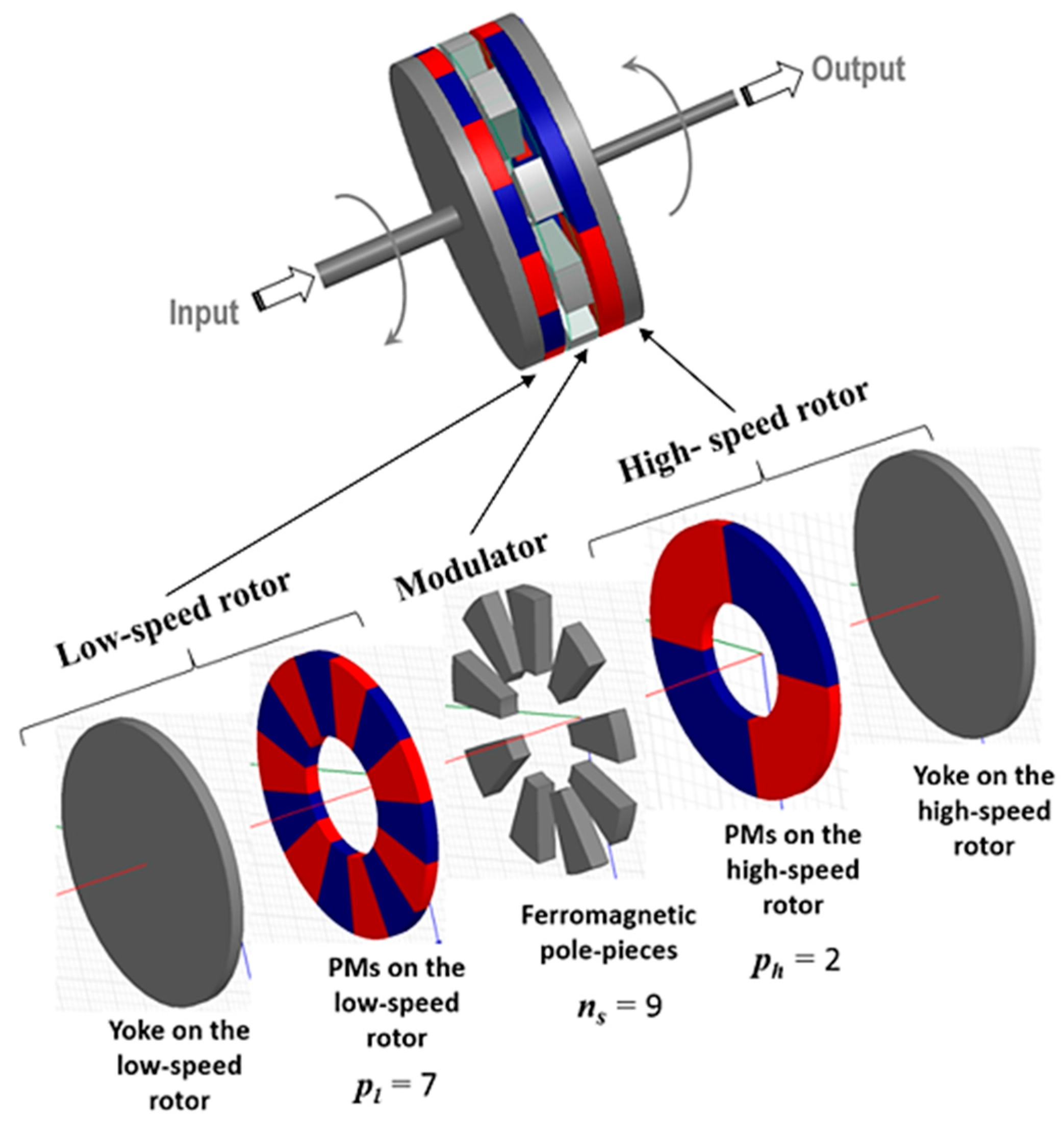
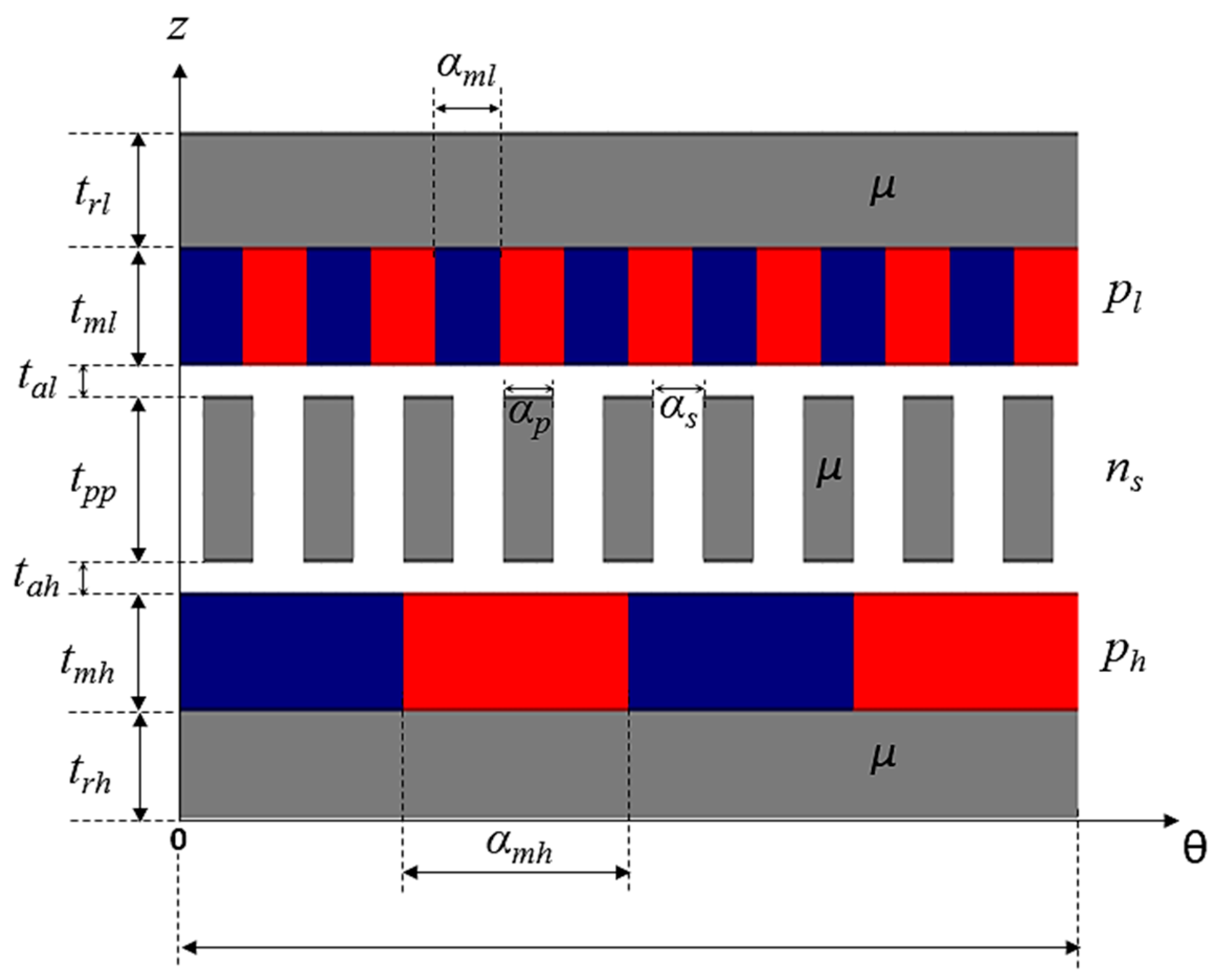
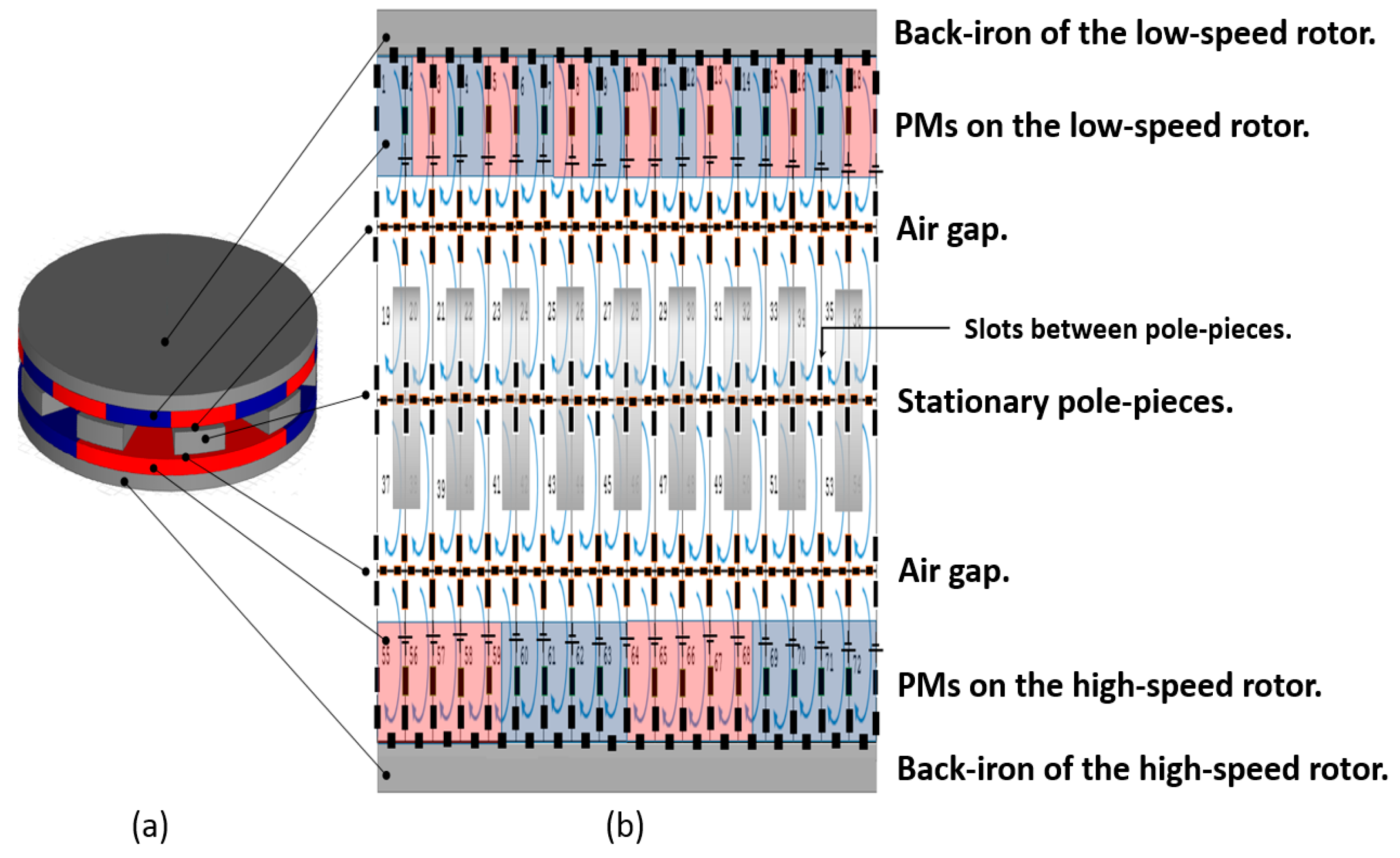


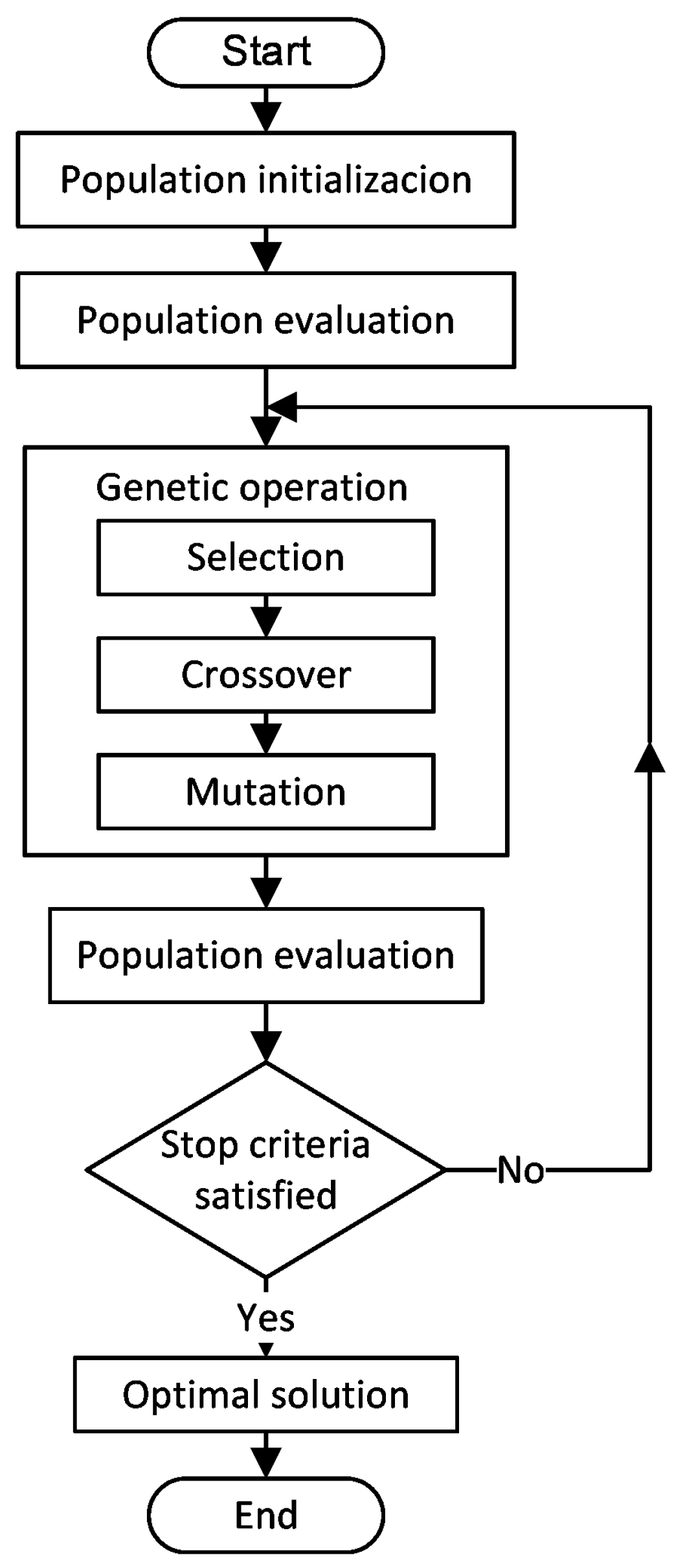
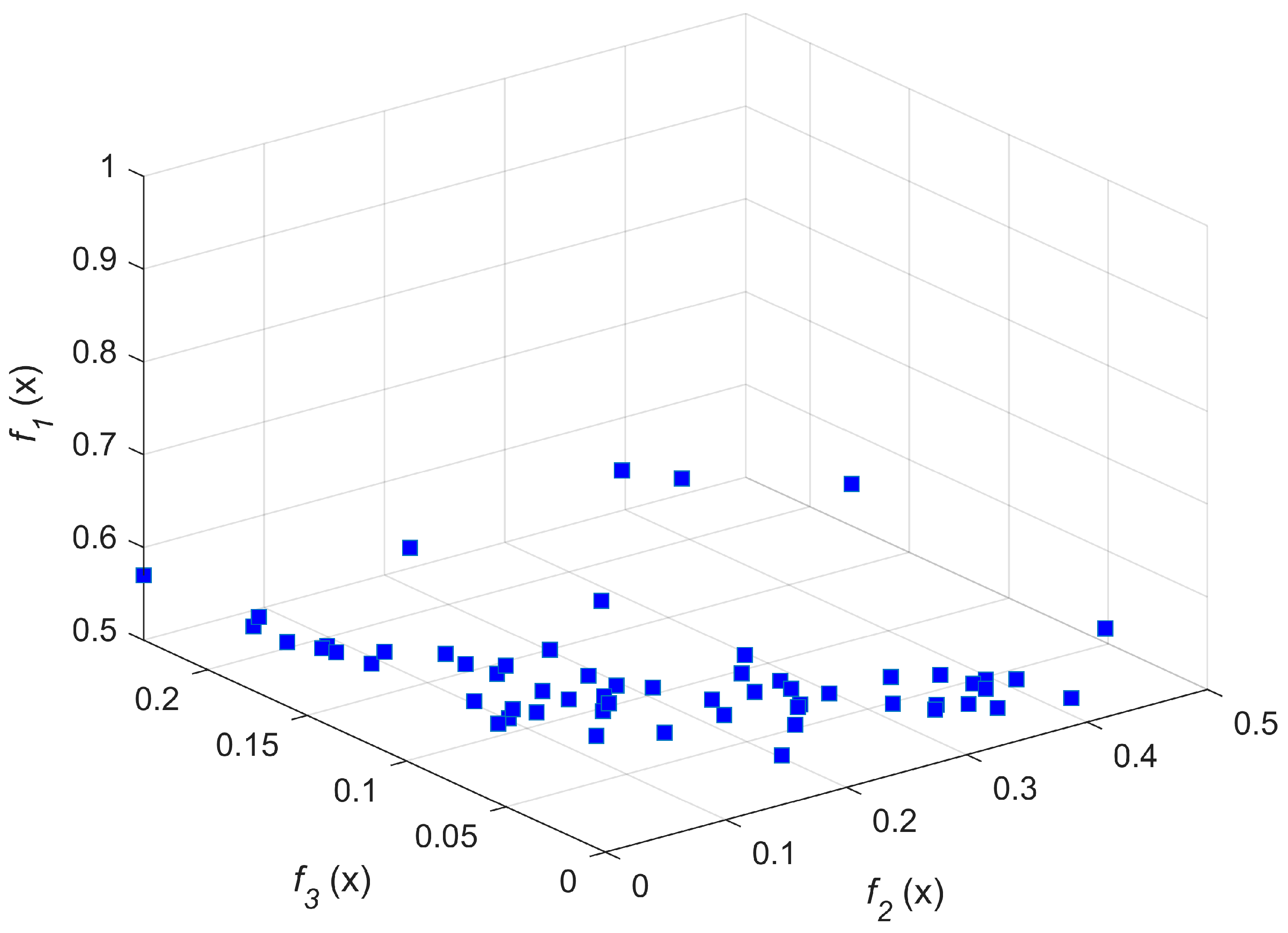




| Symbol | Quantity | Value |
|---|---|---|
| pl | Pole pair numbers of low-speed rotor | 7 |
| ph | Pole pair numbers of high-speed rotor | 2 |
| ns | Number of ferromagnetic pole pieces | 9 |
| Gr | Gear ratio | 3.5 |
| trl | Low-speed rotor yoke thickness | 7 mm |
| tml | Low-speed rotor permanent magnet thickness | 7 mm |
| tal | Air gap near the low-speed rotor | 2 mm |
| tpp | Length of the ferromagnetic pole pieces | 10 mm |
| tah | Air gap length near the high-speed rotor | 2 mm |
| tmh | High-speed rotor permanent magnet thickness | 7 mm |
| trh | High-speed rotor yoke thickness | 7 mm |
| ri | Inner radius | 30 mm |
| ro | Outer radius | 70 mm |
| al | Pole-arc-to-pole-pitch ratio of low-speed PMs | 1 |
| ah | Pole-arc-t- pole-pitch ratio of high-speed PMs | 1 |
| αml | Width of the low-speed rotor permanent magnet | 0.4488 rad |
| αmh | Width of the high-speed rotor permanent magnet | 1.5708 rad |
| αs | Slot opening | 0.3491 rad |
| αp | Width of the ferromagnetic pole piece | 0.3491 rad |
| Br | Remanence of the magnets | 1.25 T |
| Hc | Coercive force | −995 kA/m |
| Design Variable | Lower Bound (mm) | Upper Bound (mm) | Optimum Value (mm) | |
|---|---|---|---|---|
| ro | Gear outer radius (x1) | 50 | 71 | 59.49 |
| ri | Gear inner radius (x2) | 20 | 31 | 27.56 |
| trl | Low-speed rotor yoke thickness (x3) | 6 | 12 | 6.62 |
| tml | Low-speed PM thickness (x4) | 6 | 12 | 8.55 |
| tpp | Ferromagnetic pole pieces thickness (x5) | 9 | 15 | 11.2 |
| tmh | High-speed PM thickness (x6) | 6 | 12 | 7.51 |
| trh | High-speed rotor yoke thickness (x7) | 6 | 12 | 6.97 |
| ta | Air gaps length (x8) | 1 | 4 | 1.85 |
Disclaimer/Publisher’s Note: The statements, opinions and data contained in all publications are solely those of the individual author(s) and contributor(s) and not of MDPI and/or the editor(s). MDPI and/or the editor(s) disclaim responsibility for any injury to people or property resulting from any ideas, methods, instructions or products referred to in the content. |
© 2023 by the authors. Licensee MDPI, Basel, Switzerland. This article is an open access article distributed under the terms and conditions of the Creative Commons Attribution (CC BY) license (https://creativecommons.org/licenses/by/4.0/).
Share and Cite
Ruiz-Ponce, G.; Arjona, M.A.; Hernandez, C.; Escarela-Perez, R. Design Optimization of an Axial Flux Magnetic Gear by Using Reluctance Network Modeling and Genetic Algorithm. Energies 2023, 16, 1852. https://doi.org/10.3390/en16041852
Ruiz-Ponce G, Arjona MA, Hernandez C, Escarela-Perez R. Design Optimization of an Axial Flux Magnetic Gear by Using Reluctance Network Modeling and Genetic Algorithm. Energies. 2023; 16(4):1852. https://doi.org/10.3390/en16041852
Chicago/Turabian StyleRuiz-Ponce, Gerardo, Marco A. Arjona, Concepcion Hernandez, and Rafael Escarela-Perez. 2023. "Design Optimization of an Axial Flux Magnetic Gear by Using Reluctance Network Modeling and Genetic Algorithm" Energies 16, no. 4: 1852. https://doi.org/10.3390/en16041852
APA StyleRuiz-Ponce, G., Arjona, M. A., Hernandez, C., & Escarela-Perez, R. (2023). Design Optimization of an Axial Flux Magnetic Gear by Using Reluctance Network Modeling and Genetic Algorithm. Energies, 16(4), 1852. https://doi.org/10.3390/en16041852







